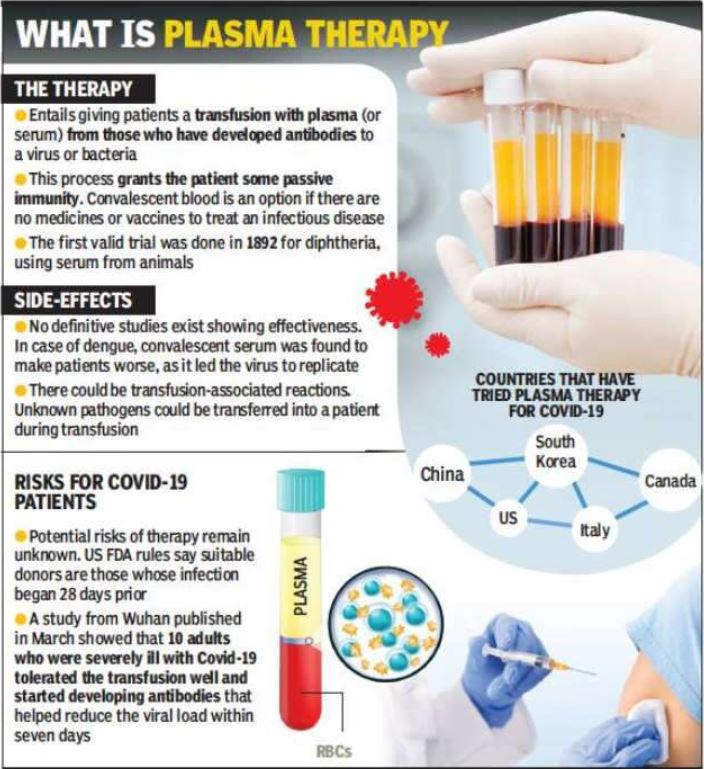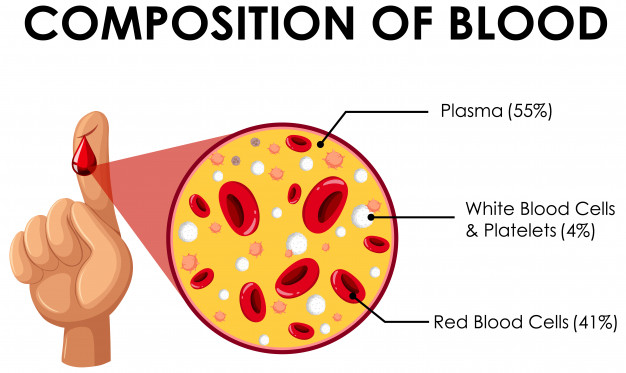Plasma Therapy for COVID 19
2020 APR 17
Mains >
Science and Technology > Bio technology > New discoveries

IN NEWS:
Several countries, including India, are seriously looking at plasma therapy as a potential treatment for Covid-19.
WHAT IS PLASMA IN BLOOD:
- Plasma is the liquid portion of blood. About 55% of our blood is plasma, and the remaining 45% are red blood cells, white blood cells and platelets that are suspended in the plasma.

- Plasma is about 92% water. It also contains 7% vital proteins such as albumin and anti-hemophilic factor, and 1% mineral salts, sugars, fats, hormones and vitamins.
- When separated from the rest of the blood, plasma is a light-yellow liquid.
- Plasma serves four important functions in our bodies:
- Helps maintain blood pressure and volume.
- Supply critical proteins for blood clotting and immunity.
- Carries electrolytes such as sodium and potassium to our muscles.
- Helps to maintain a proper pH balance in the body, which supports cell function.
USES OF PLASMA:
- Plasma is commonly given to trauma, burn and shock patients, as well as people with severe liver disease or multiple clotting factor deficiencies.
- It helps boost the patient’s blood volume, which can prevent shock, and helps with blood clotting.
- Pharmaceutical companies use plasma to make treatments for conditions such as immune deficiencies and bleeding disorders.
CONVALESCENT PLASMA THERAPY:
- The idea of convalescent plasma therapy is based on the premise that the blood of a patient who has recovered from Covid-19 contains antibodies with the specific ability of fighting novel coronavirus.
- Antibodies are developed in a patient as part of the body's natural immune response to a foreign pathogen or in this case, the novel coronavirus. These antibodies are highly specific to the invading pathogen and so, work to eliminate the novel coronavirus from the patient's body.
- The theory is that the recovered patient's antibodies, once ingested into somebody under treatment, will begin targetting and fighting the novel coronavirus in the second patient.

- The convalescent plasma therapy is akin to passive immunisation as it is a preventive measure and not a treatment for the Covid-19 disease.
- This is not the first time plasma therapy is being considered as a treatment for viral infections. WHO had recommended its use in the treatment of Ebola and Middle East respiratory syndrome (MERS) in 2014 and against H1N1 in 2009.
RISKS INVOLVED:
- Transfer of blood substances: As the blood transfusion takes place, there are risks that an inadvertent infection might get transferred to the patient.
- Enhancement of infection: The therapy might fail for some patients and can result in an enhanced form of the infection.
- Effect on immune system: The antibody administration may end up suppressing the body's natural immune response, leaving a Covid-19 patient vulnerable to subsequent re-infection.
- Unknown side effects: No definitive studies exist on the potential side effects of the treatment. For instance, in case of dengue, convalescent serum was found to make patients worse, as it led the virus to replicate.
CONCLUSION:
- The studies have sparked a ray of hope in the battle against the coronavirus pandemic. However, researchers caution that it's too early to think of plasma therapy as an effective treatment.
- There are too many unknowns right now. The sample sizes in the Covid-19 plasma therapy trials are too small to arrive at definite conclusions.
- So, while plasma therapy remains a ray of hope, we will only know the treatment's efficacy once more studies and trials are conducted.


